By Susan Burrer
...how do you go on a mission trip and not be changed in some way—not possible. First of all—what is a “mission trip”? I believe it is whatever God speaks to your heart to do for others, whether across the street or in some far-off corner of the world; it is your particular way to pass on your blessings—play it forward—in my case, building houses with the people of El Salvador...only it is SO much more than that!
This was my fourth trip, the first three building Villa Esperanza, a Thrivent/Habitat for Humanity village of 75 houses, a community center, a preschool, and an outdoor marketplace—all now complete; this time, Getsemani, a community on the outskirts of Ahuachapan. Here, Thrivent/Habitat will build 90 houses over 3 years and develop programs in community leadership, values education, community health, cultural exchange, and microentrepreneurship. Ahuachapan is a city nestled in the valley of the mountain range Ilamatepec, located in the department of Ahuachapan, one of the 14 in El Salvador, bordering Guatamala and the Pacific Ocean. This department is rated as extreme poverty...what will that mean to us throughout the week?
Our team of 13, the other 12 from North Dakota, hooked up in the airport at San Salvador with Aleks, a local Habitat employee and friend from previous trips, and stayed the night there at the LaPosada del Angel Hotel, a quaint, very hospitable, little place, where we had orientation and regrouped our gifts of health/school supplies for the children of the church and those to take to the village. We also had our first El Salvadorian meal of various pupusas, a thicker tortilla made with freshly ground corn dough and stuffed with cheese, beans, or meat, and then grilled...yum!
| ||
| From El Salvador 2011 |
Church—Sunday morning we loaded up everything again for the hour ride to Santa Ana...our team picked going to Cristo Rey Lutheran Church again, where we have been going the past four trips, instead of a larger church in San Salvador. There is something truly spiritual worshiping here, even though there isn’t much of the church and surrounding buildings left after it was destroyed in an earthquake in 2001. The church motto is “we are a poor church who serves the poor,” as most of the members are low-income families who work as day laborers, factory workers, or street vendors and many do not have decent homes themselves, but yet actively supported Habitat by coming to build houses for others in Villa Esperanza every Saturday. We also pick up our interpreter, Ronald, an awesome young man, an El Salvadorian, very compassionate with a truly caring heart, and perfect for the role he has in keeping everything going!
| ||||
| From El Salvador 2011 |
One little elderly lady in particular touched our hearts from the first time we met her—and don’t let her small size of not even 4 feet fool you—she was still quite able to sift sand or move block with the best of them!—but as she opened her small coin purse in church and removed the few remaining coins, she just had a glow about her, and was pleased that she could contribute to God’s work, and us knowing that it no doubt probably was her last coins—she had faith, and gave them with a thankful heart...
 |
| From El Salvador 2011 |
As usual, the newest members on our team got to participate in the service by reading the lessons in English and serving the communion. The songs are all sung in Spanish, without a piano...we try to keep up the best we can, some better than others!...but it is especially enlightening when the song is one we sing in our church, such as “Lord, You Have Come to the Lakeshore,” which we’ve sang three out of the four times! And no, I have not been requesting it, but it is so moving when sung in Español a cappella. When the service was over, all the children got up to sing several songs for us. We then presented the school and health kits we brought for them.
Accommodations—the opposite end of the spectrum this time...instead of staying in the midst of the busy city of Santa Ana, we are staying up on a mountain side at Hotel Alicante Montana (almost 5,000 ft in elevation), a beautiful, peaceful setting despite the armed guards at the gate...rustic but very moderized ...but still, we must stay focused...use bottled water for things like brushing our teeth, and no paper in the toilet...neither comes natural! There is no air conditioning, but not now needed, especially every evening when the sun sets, the strong mountainous “river of winds” pick up, blow like crazy!, all night until sunrise, when they normally go down for the day. After a hearty breakfast of eggs, beans, plantains, fresh fruit, and plenty of their wonderful locally grown coffee, we are ready for the 25-minute van ride down the mountain to embark on our mission.
As we start our further descent into Getsemani on the rocky trail with big pot holes from the recent torrential rains, we see building is going to be a little more challenging here with the slope of the hillsides. We will find out more about that as the week progresses! As we wind through the village, many people wave or call out to us “hola” (hello) or “dias” (short for buenos dias, or good morning). The children are especially curious to see who is coming this week!
Since this co-Thrivent/Habitat for Humanity El Salvador project has been in progress all year, the community center has already been built. This is the center of activity where we will eat lunch every day, cultural exchanges take place, training for various things within the village is held, AND it has two flush toilets for our use! Latin American people are very artsy and the inside of the Center is painted reflectively, with a beautiful mural all across the front, depicting how they envision the village. Our first introduction to the families, masons, and helpers we will be working with takes place...even the little children got up to tell us their name, welcome us, and thank us for coming to help build...truly heart-warming...
| ||
| From El Salvador 2011 |
The Build—We will be working on three houses, two just a half block from the community center, side by side, and another a block away. The houses are all single-family style here, again no larger than 400 square feet, with two 9x9 foot bedrooms, an open area for living (where many times they run a small business in part of that space also, such as a tienda (store) or hair salon), a patio area where they do all the cooking on little stoves and the large cement, three-compartment sink resides for ALL purposes, and then the small bathroom that has running water with a sink, shower, and a flush toilet! They are built to be earthquake resistant. It seems there is much weather-related activity in this area...volcanoes, earthquakes, hurricanes, torrential rains, flooding, mudslides...just when it seems like they are getting ahead, something happens to set them back again...it just doesn’t seem fair.
The first of the three houses has the footers dug, which is done by digging trenches by hand—no forms—and bucket brigades (human chains) to move the dirt, tamp the soil, and join rebar to build somewhat of a frame for the cement blocks to slip over when building the walls, to tie it all together. There are a few rows of block already up. Only the local masons can lay the block with a mortar called mezcla and volunteers fill in the center holes around the rebar with chispa. Blocks have to be moved, sand sifted, and “something” transported in the wheelbarrows. Work continues all week building the walls with this family.
House 2 is farther along—work progresses putting the final rows of block on, and before the week is over, the corrugated metal roof is put on, sidewalks and patio are poured, septic tank dug, floor prepared for the tile, and walls both inside and out are prepared for painting. Has anyone shovel-dug a 6-foot-deep hole by about 4 feet wide lately on a 90-degree day?!
House 3—the house I worked on all week—was going to be the residence of Francisco, his wife Evelia, two of their sons who are in their 20’s, and a couple grandchildren who sometimes stay there while their parents work. It appeared that 50% of the block laying was done, so in between hand mixing the mescala and chispa for the masons or hauling blocks up the hill in semi-rollable wheelbarrows, our job was to build up the floor...not so bad I thought...I’m experienced moving dirt!
| ||
| From El Salvador 2011 |
After our pile of loose dirt from digging out the footers was gone, we would need to pickaxe the dirt apart on the mountain, pull out all garbage and tree roots...anything that would later decay and create a hollow spot under the tile, and by bucket brigade, the dirt would be passed into the house and dumped, bucket after bucket, maneuvering around the scaffolding set up in the doorways and throughout the house, until there was about 4 inches everywhere. Then, it would need to be tamped (compacted) to prepare for the next layer, and the next, and the next... (a handmade tamper is created by an empty paint can filled with cement with a tree branch handle in it). Each morning we would ask the masons, “quantos mas” (how much more), to which they would reply “poquito” (a little more)! Guess they didn’t think us gringos could handle the truth! Come Wednesday, we got an explanation that we had to build the floor up 27 cm above the elevation of the lot above ours. The amazing thing to me all the time is nobody complains—everyone just pitches in to “get ‘er done!”
| ||
| From El Salvador 2011 |
Inspiration to keep on keeping on—Unlike building Villa Esperanza where we built a whole new village on an unoccupied flat piece of ground, we learned that the shack about 15 feet behind this new house of old corrugated metal scraps, branches, mud, plastic, and whatever else there was to make a wall of some kind was Evelia and Francisco’s current home of 8 years...something you’d see in a documentary...only now, it was real...we knew their names...they had a face...we felt their hugs, these happy, loving, grateful people with much faith lived here...truly surreal for all of us...the dirt floor, the bed set up on pieces of block to keep it dry as the torrential rains wash through their house, the big barrels of clothes soaking—the laundry. You can’t feel sorry for them, in the sense that we know, because they don’t feel sorry for themselves...they look ahead, that tomorrow is going to be better...one does not really know how to feel other than it is something unfamiliar to us. There appears a new sense of urgency and strength within to “move that dirt”!
| ||
| From El Salvador 2011 |
Eventually, we heard “no mas” (no more), and moved on to put the last layers of another “recipe” that started with eight wheelbarrows of sand, all to be hand mixed twice, water added, and hand mixed twice more, and then more bucket brigades and tamping. Friday the floor was declared “done” until they put the layer of crushed lava and then tile, which would be next week’s team.
Francisco worked side by side with us every day...these people have an amazing work ethic...he did not rest it seemed. When we’d go for our 15-minute break and come back, a big mound of dirt magically appeared...he was trying to make our job easier!
| ||
| From El Salvador 2011 |
His wife Evelia was no different. She was heading up a community clean-up program with her crew working the huge lot next door when she got done working her real job. In a few hours, they “mowed” the entire lot with machetes, had it raked with “tree branch” rakes, the tall grasses loaded onto sheets of cloth or plastic, and carried off into the woods. They then proceeded to dig up the land with pickaxes and large hoes to make a community vegetable garden...truly amazing to watch them work so diligently with such primitive tools but much enthusiasm! Evelia was also “in training” to learn how to sew—many try to subsidize their income ($200/mo is a good salary for working outside the home). This “sewing group” had hoped to get the contract to sew school uniforms, which the children need before they are allowed to attend school. She proudly showed me the uniform she made when I told her I sewed too!
| ||
| From El Salvador 2011 |
...now what? We then started to sand the outside of the house. How do you sand a cement block house? By taking a smaller broken piece of block and using it as “sandpaper” until the wall is smooth, then you wet down the blocks, brush on several coats of diluted cement until the entire house is sealed, and ready for painting. When asked what color they had picked out for their house, Francisco beamed with joy...the bottom third would be brown and the top light blue, knowing that this was the first time in his sixty-some years to have a REAL house with walls to paint. ...you then get the Thrivent Global Village motto...
| ||
| From El Salvador 2011 |
Culture Exchange/Farewell Party—One of the things the masons look forward to all week is playing the great fútbol game (soccer) with us! One can see why that is the No. 1 sport in their country just watching even the smaller kyds play...they are good at it, and I’m sure it helps to be small, thin, fast, and coordinated! We also got to go back to Villa Esperanza on an outing to look over the completed village...many of us had not been there for the building of the market place, the last project before dedication of the village last November. Throughout the week we took a walking tour of more of Getsemani and visited the corn grinding station, toured through a house that was completed (they just welcome you in to take a look...nobody is concerned whether it is up to par for visitors or not; if you don’t have much “stuff,” it can’t be out of place!), bought a coke from the tienda in the house a couple doors down from where we were working...interesting concept! They don’t want you to take the glass bottle because it is refillable...so...they dump it into a clear plastic bag, tie it shut, and you bite the corner off and sip it out of there when you are ready!
| ||
| From El Salvador 2011 |
...oh no, not Friday ALREADY...which means saying goodbye to our new friends is inevitable. The families whose houses we worked on all week got up to gratefully thank us all for coming to help build...that it just isn’t about the house, but hope, a way to a better life, and that people like us who don’t even know them, care, and come to help. It is almost impossible to maintain dry eyes through their heartfelt thankfulness.
Some of the local ladies prepared authentic El Salvadorian food for us, while we made “dirt cups” (crushed oreos, chocolate pudding, and gummy worms) for all of them! I believe it was their first time for dirt cups, and after a little hesitancy—about the worms perhaps!, they seemed to really enjoy them! ...then the mariachi comes around the corner and it is now time to be joyous and celebrate the week with music and dancing!! All too soon the party is over!
Why go there, people ask, there is plenty of people in need here? What truly inspires someone to keep going back after the first time, now knowing the work that is involved, and the conditions...it is something that really has no explanation...just a calling to do something I guess. One lady from a Canadian team working there in a different village with Habitat was there for her fourteenth time; most on our team have been there at least four times...what is it? Perhaps it is literally the sweat and tears that one shares working side by side with the families...you look into their faces and know they have some story...you cannot really speak, at least not in words, but the connection of our hearts is much more powerful than words could ever be. Perhaps it is the gratefulness in their faces and the feeling in their hugs. They may be poor in material things but they are much richer in faith, happiness, and spirit than we could ever hope to be...there is MUCH to be learned from our new friends.
| ||||
| From El Salvador 2011 |
Las Ruta De Las Flores (the route of the flowers). Our team voted to tour the coffee fields/hiking, Apeneca (an artsy shopping town), and zip-lining for our Saturday adventure day! Our guide took us to the coffee bush field where he explained
the growing process of coffee. All the dark green criss-cross trees on the mountain side are to protect the coffee beans from being blown off the plants. We then continued our hike to the top of the volcano (beautiful views) and down to the lake inside of it, where there was a flower farm. After a delicious lunch on the patio back at the base, we went to Apeneca to check out the shops, have a fresh cup of coffee, and then on to do zip-lining! The open-air bus ride up to the top was great, and the 14-leg zip-lining was awesome! The longer runs took you out across the canyon! Did I say it was AWESOME! We went back to San Salvador for the night as most had an early flight Sunday morning. As we said our team goodbyes, we wondered...not IF, but WHEN, we get to come back to El Salvador again...as our bonds are not easily broken...

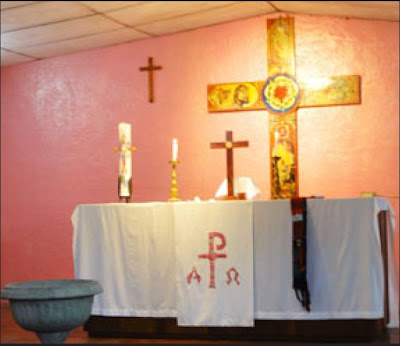
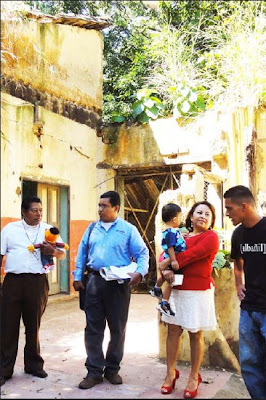
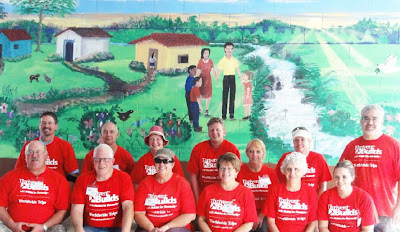

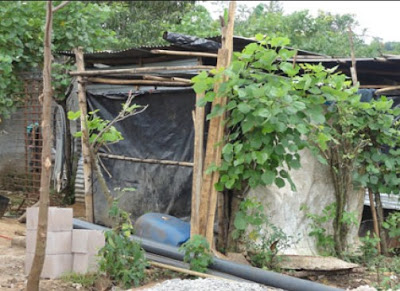

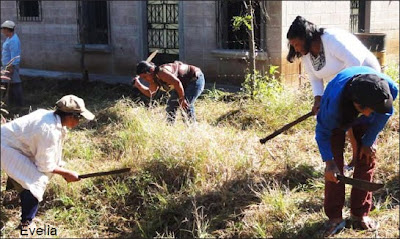



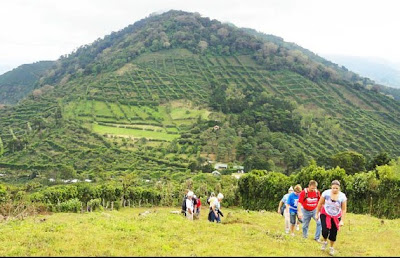
Thank you for sharing your journey and for sharing your photos. This is God at work!
ReplyDeleteBeautiful! I was on a team that worked on Miss Evelia's home in October....until the rains came. We stayed at the same place....it was great reading your story.....thank you for sharing!
ReplyDeleteTruly amazing! Bless you all for what you do and share. Life more meaningful and our world touched by angels like you.
ReplyDelete